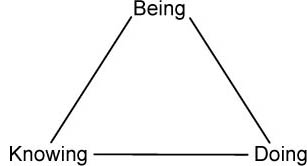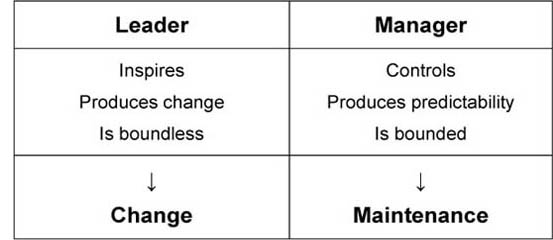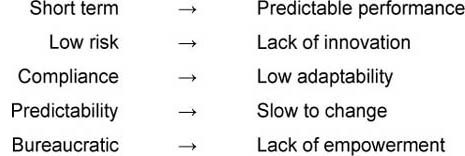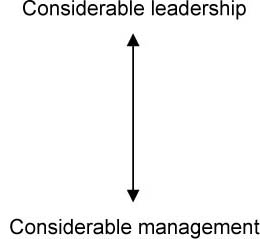CHAPTER 1: WHAT IS LEADERSHIP?
In this chapter I provide:
• A description of what makes a great leader.
• An outline of the difference between leading and managing.
• A self-assessment tool for finding whether you spend most of your time managing or leading, and the implications of that for you, your colleagues and your customers.
What makes a great leader?
I was working in a business recently that had undergone a lot of change. Morale in the organisation was poor and there was uncertainty about the future. There was generally a stale air about the place and productivity was low.
There were several departments, however, including IT, where the atmosphere was entirely different. People in these departments had a buzz about them, they talked positively about the future and appeared energised and enthused. I left the IT department wondering what was so different about the people there. They were working in the same conditions and had undergone the same changes.
The key difference for each of these departments was that they had strong leaders in place. They had created an environment for their people where they wanted to give of their best, to go above and beyond the call of duty, in spite of the difficult circumstances.
You will have your own experiences of great leaders – either those you’ve seen from afar or those you’ve worked closely with. If you take a few minutes to think about those people, to identify exactly what it is that makes them great leaders, you’ll probably pick certain characteristics, such as that a great leader:
• is an effective communicator,
• is passionate,
• demonstrates integrity,
• challenges the status quo,
• is visionary,
• is motivational and
• is charismatic.
One management psychologist, John Gardner, studied a large number of leaders. He came to the conclusion that there were some qualities or attributes of leaders that suggested that a leader in one situation could lead in another. These included:
• energy and stamina,
• courage and resolution,
• trustworthiness,
• decisiveness,
• self-confidence,
• assertiveness,
• intelligence and an orientation towards action,
• eagerness to accept responsibility,
• ability to undertake a task,
• awareness of the needs of followers,
• skill in dealing with people,
• capacity to motivate people and
• adaptability and flexibility.
However, researchers who followed Gardner challenged this list and it is certainly not exhaustive. One thing that is agreed is that in order to be an effective leader you need to have followers. Followers are inspired by what leaders know (about themselves, other people, the business, the competitive environment, and so on) and what they do, but above all by how they are, by their very being, modelling the role of a leader with total integrity and intuitively behaving like one.
The following triangle depicts this dynamic: being, knowing, doing.

Figure 1: Being, knowing, doing
One definition of leadership is that leadership is about influencing others to achieve organisational goals. The effective leader takes people to places that they did not know they wanted to go themselves.
In order to do this, they need to have a strong sense of who they are, as well as a clear vision for the future. Business author Warren Bennis says, ‘Leadership is a function of knowing yourself, having a vision that is well communicated, building trust among colleagues, and taking effective action to realise your own leadership potential.’
So shouldn’t it just be senior managers at the top of the organisation that need leadership skills, rather than departmental managers?
Leading versus managing
Elisabeth Moss Kanter is a Professor at Harvard Business School who specialises in change. Her view is that change is now a fact of life for all businesses. She says that in changing times, not only is stronger leadership required, but also more leaders.
This means that managers at all levels of the organisation need to demonstrate leadership qualities. So let’s start by looking at the difference between managing and leading – what it is that we do when we manage as opposed to what we do when we lead in an IT environment.
This is not a question of your title – for example you may be called a ‘manager’ or a ‘team leader’ – it’s a question about what a manager or a leader does, about what behaviours they display.
So where do managers tend to focus their attention? This tends to be around setting objectives, monitoring, setting procedures, getting things done, ensuring that effective processes and procedures are in place.
And what about leaders? Leaders focus more on inspiring, setting strategies for the future, role modelling, coaching others to reach their potential, empowering others.
One of the key differences is the focus of manager behaviour on the here and now, on getting things done. The focus for the leader is on the future, on looking for different ways of doing things. This is a proactive approach as opposed to a reactive one.

Figure 2: Leading versus managing
Self-assessment – where do you spend your time?
Imagine there is a continuum, with managing on one end and leading on the other – where would you plot yourself, bearing in mind the activities you do and get involved in on a daily basis?
Figure 3: Where do you focus your efforts?
What are the consequences of where we focus our attention?
Let’s look first at what happens if the amount of time we spend on leadership and the amount of time we spend on management are out of balance. In other words, a team has strong management and weak leadership. This is what we are likely to see:

Figure 4: Strong management and weak leadership
Conversely, if a team has strong leadership and weak management, these are the potential consequences:

Figure 5: Strong leadership and weak management
So when should we lead and when should we manage?
Let’s look at the dynamics that tell us whether we should be managing or leading in our business environment. The following diagram shows two axes: the x-axis represents the complexity of your operation. In other words, the range of products and services that you offer and the number of different places where your organisation interfaces with the customer. The y-axis represents the degree of change that a market sector is experiencing.
Figure 6: Leadership-versus-management matrix
You will see from the matrix that considerable leadership and little management would work for a small, highly motivated group of people – perhaps a company that does a lot of research and development or innovation.
Little leadership and little management would work for a small-business owner offering one product or service in a market place where there is little change, such as window cleaning or car valeting.
Considerable management and little leadership would work in a production or manufacturing environment where there is a lot of emphasis on managing processes or production and where there is little change, such as a stationary company, getting the same sort of supplies from A to B.
Considerable leadership and considerable management would work well in any organisation where there is a large amount of change and the complexity of the operation is high, such as air travel, insurance, banking, the car industry, the leisure industry, the IT industry, and so on.
I am not saying here that managing is bad and leading is good. What I am trying to emphasise is that in the IT environment, you will need to be both an effective manager and an effective leader. The problem for most individuals is ensuring the balance and being clear when to manage and when to lead. As the business writer Steven Covey so aptly puts it, ‘Management is efficiency in climbing the ladder of success; leadership determines whether the ladder is leaning against the right wall.’ The following chapters provide you with practical advice on how to be a better leader in order to influence positively your team in order to achieve organisational goals.
Activities to undertake with your team
In order to increase your understanding of what others see as effective leadership, I suggest that you ask your team members what they see as the characteristics of great leaders. Discuss with them and your colleagues the differences they see between leading and managing and how this applies in your organisational context.
Summary
This chapter has provided you with a description of what makes a great leader and an outline of the difference between leading and managing. I have also encouraged you to assess whether you spend most of your time managing or leading or both, and the implications of that on you, your colleagues and your customers.
Here are some questions to ask yourself after reading this chapter:
• Given your organisational and market environment, where should be the emphasis on leadership and management be for you?
• What can you do to redress the balance, if required?
• What do you need to do more of or do differently?
• How do you currently rate yourself against the characteristics of a good leader?
• What is a key area of strength for you in terms of leadership? What is an area that you need to develop further?


